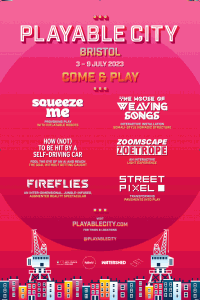Six playful creative prototypes ranging from huge inflatable robots to an interactive pavement will pop up around Bristol next month, showcasing the way the city brings art, technology and culture together.
The projects are designed to fire the imagination and spark conversations around inclusion, surveillance, climate change and the kind of cities we want to live in. 
Bristol media centre Watershed, in partnership the University of Bristol-led MyWorld creative technology programme, has financed the creative teams behind the prototypes in the latest version of its innovative Playable City scheme, which runs from 3-9 July.
Watershed launched the Playable City Award 10 years ago, inviting artists from across the globe to create playful, creative technology installations that put people and play at the heart of the future city.
Since then it has worked with around 75 partners and 50 creatives from Lagos to Recife, Tokyo to Melbourne and Singapore to Austin, reaching more than 1m people globally in the process.
The latest six new commissions have each been awarded £45,000 to build their prototypes.
The commissions are part of the Playable City Sandbox, a shared development programme produced by Watershed and MyWorld, which is funded by UK Research and Innovation’s Strength in Places Fund, to help support and grow the creative technology ecosystem of the West of England.
The six Playable City commissions are:
Squeeze Me, created by Emma Powell, Robert Nixdorf and Richard Sewell of Bristol creative robotics studio Air Giants, uses inflatable soft robotic technology to create a compelling and charming tactile and visual experience. Up to 10 huge, inflatable and illuminated creatures, wrapped around trees, lampposts or other street furniture, invite passers-by to hug, squeeze, lean on or poke them. Creatures will respond with shape-change, light and sound and will influence other creatures nearby. Where: Brandon Hill Park. When: 4 – 6 July, 4 – 10pm; 7 – 8 July, 2 -10pm; 9 July, 2 – 6pm.
Inspired by the Somali-style nomadic structure called the Aqal and created by Fozia Ismail and Ayan Cimli of Dhaqan Collective, The House of Weaving Songs is an interactive installation co-created with Somali communities in Bristol and beyond, integrating Somali weaving songs and woven tapestries in an experiment to connect the city to cultural practices that can inspire us in our fight to tackle climate change. Where: Trinity Community Garden. When: 7 – 8 July, 12 – 6pm; 9 July, 12 – 4pm.
How (not) to be hit by a self-driving car, created by Tomo Kihara, Saki Coppen and Dan Coppen of Studio Playfool, is a game that challenges people to avoid being detected as human in the eye of an AI. With surveillance cameras becoming smarter and the cities we live in starting to see us back, it poses the question; how do they see us? Anyone can join the game, but can they get from start to finish without being detected? Where: M Shed. When: 3 – 7 July, 12pm – 6pm.
Zoomscape Zoetropic is a light experience, designed by Jack Wates & Thomas Blackburn to be viewed from moving train windows arriving and departing from Bristol Temple Meads station. The content changes with each passing train, creating a new experience for passengers on daily commutes. Where: Queen Square When: 5 – 6 July, 9pm – 11pm
Created by Mike Salmon and Ossian Whiley of Glitch AR, Screaming Color & Arcane, Fireflies is a transformative immersive experience using virtual content to turn the streets and landmarks of Bristol into a colourful, sci-fi-infused digital jungle, awash with mesmerising visuals and local music. Where: Lakota Nightclub. When: 5 – 7 July, 10am – 6pm.
Street Pixel is hardware graffiti; designed by Tom deMajo and Malath Abbas, Biome Collective & Sarah Selby to reinvigorate the relationship between people and their cities by transforming the street below into opportunities for connection and play using creative technology, game design and a sustainable approach to materials and electronic hardware. Where: Watershed. When: 6 – 7 July, 10am – 4pm.
Watershed research lead Furaha Asani said: “We’ve spent the past few months in an intensive R&D process- the sandbox- where teams have gotten the chance to learn, build, and test their prototypes.
“The teams have been supported by an amazing panel of industry advisors and have also been friendly sounding boards for one another. It’s been a fun, challenging, and playful process and we’re really excited for you all to see and play with the final projects.”
MyWorld operations director Oscar De Mello added: “It’s been genuinely inspiring to see these Playable Cities projects come to life. The companies and individuals involved each bring a unique perspective and design approach to their installations and the results show the range of creative talent and skill available here in the West of England. Huge thanks to Watershed for enabling this opportunity, and I can’t wait to go and play.”
Over the past four years, Playable City has provided an inclusive playground for many cities across the globe ranging from an interactive pack of origami-like light-projected
Following the last Playable City Awards in 2016, its model was adapted and developed to forge long term partnerships with like-minded producers from different cities around the world culminating in a creative producers international programme.






























